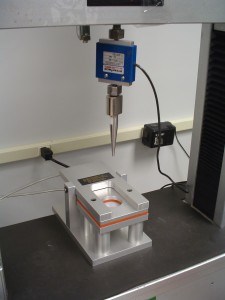Our next blog post in our series on common methods for testing of films will focus on puncture resistance testing.
 Puncture resistance testing is another widely used method to test films. Common test methods include ASTM D1709, ASTM D3240 and ASTM F1306. Choosing the test method is often one of the more difficult steps for puncture testing. It is important to consider the end use of the film to determine the appropriate test method since the values for impact resistance from one method to another cannot be correlated to one another.
Puncture resistance testing is another widely used method to test films. Common test methods include ASTM D1709, ASTM D3240 and ASTM F1306. Choosing the test method is often one of the more difficult steps for puncture testing. It is important to consider the end use of the film to determine the appropriate test method since the values for impact resistance from one method to another cannot be correlated to one another.
Determining the material properties of interest can help guide the user to the proper test method. For example, ASTM D1709 will only provide the mean failure energy to break for a group of samples where as ASTM F1306 will provide peak load, energy to break and penetration distance for every sample. For penetration tests like ASTM D1709 and ASTM D3420 it is important to provide enough material for testing and set up. These tests tend to take more exploratory work prior to testing to dial the test equipment into the proper range. Another variable to determine is which side of the material to impact. Some films with laminate structures may have varying results for each impacted face of the material. During the test it is also important to monitor and prevent slippage within the clamping mechanism because this will give lower force and higher elongation results.
This blog post was adapted from a recent article by Amy Peterson, DDL’s P&M Lab Manager.